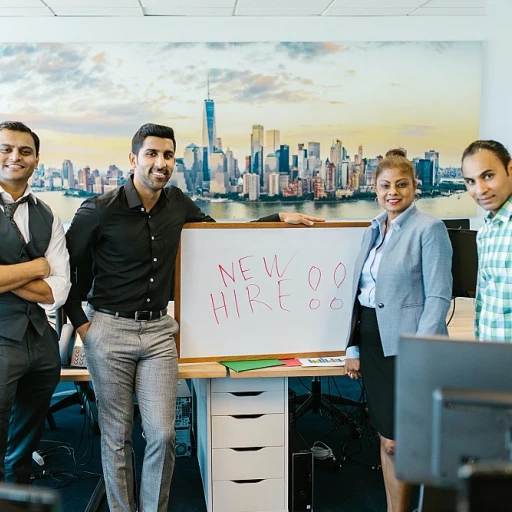Understanding Reskilling and Its Importance
Why Reskilling Matters for Everyone
In today's fast-paced business settings, the demand for fresh skill sets in the workforce has never been higher. Reskilling and upskilling are more than just buzzwords; they are essential responses to the ever-evolving job market driven by technological advances like artificial intelligence, the COVID pandemic, and shifting economic landscapes. Employers are increasingly leaning on these strategies to build a future-ready team that's equipped to tackle new challenges head-on. Consider how swiftly technology impacts our lives and reshapes industries. Businesses of all sizes are constantly on the lookout for individuals with relevant skills to keep pace with modernization—be it in areas like data analytics, supply chain management, or customer relations. Reskilling becomes the cornerstone of maintaining a competitive edge, ensuring that both businesses and their employees continue to grow.Empowering Workers through Education and Training
Education plays a crucial role in maintaining a dynamic workforce. Community colleges and higher education institutions are pivotal in facilitating this transition by offering tailored courses and training programs in line with current market needs. These initiatives often bridge the skills gap, aligning the workforce's knowledge base with industry requirements. Investing in reskilling programs can prevent the long term instability of the labor market. Organizations that focus on training and development often report higher levels of employee satisfaction and loyalty. Workers who participate in ongoing education and reskill themselves are more likely to find meaningful employment opportunities and contribute to economic development.Reskilling and the Bigger Economic Picture
The impact of reskilling goes beyond individual and organizational benefits—it extends to economic growth on a larger scale. A workforce well-versed in new technologies and methodologies can dramatically improve productivity and innovation, fostering a more robust and resilient economy. However, implementing effective reskilling programs is no cakewalk. Numerous challenges, ranging from employee buy-in to adequate funding, can pose significant hurdles. Yet, when stakeholders, including the government, educational entities, and the private sector, unite their efforts, they can create an ecosystem ripe for development and progress. By boosting employee engagement through reskilling, organizations are better positioned to adapt and thrive. As the workforce becomes more skilled, opportunities for economic growth multiply, creating a positive ripple effect across industries and communities. Discover how successful strategies and case studies play a role in realizing these outcomes by reading more about boosting employee engagement through reskilling.The Impact of Reskilling on Economic Growth
The Ripple Effect on the Economy
Reskilling isn't just a buzzword thrown around in boardrooms—it's become a crucial driver for economic growth. When employees gain new skills, they don't just improve their job prospects. They become catalysts for broader economic benefits. By enhancing their knowledge, they fill in the so-called skills gap, bolstering industries that desperately need a future-ready workforce. This shift results in increased productivity—a win-win for both workers and businesses.Reskilling and the Labor Market
In the labor market, we're seeing a shift like never before due to technology and unexpected elements like the COVID pandemic. This change demands reskilling to prepare workers for new jobs in emerging sectors. Businesses flourish when their teams adapt to new tools and technologies. Upskilling reskilling programs play an essential part, feeding into a cycle of growth, where workers' improvements lead to economic development.Changing Skill Sets and Industry Demand
Industries are in constant flux, yet there's hope. The demand for employees equipped with up-to-date skill sets continues to rise, fueled by advancements like artificial intelligence and renewed interest in data-driven decision-making. Workers skilled in current tech not only meet market needs but often exceed them, pushing innovation boundaries. Community colleges and higher education institutions take center stage here, offering accessible education pathways that adapt to industry demands, ensuring there's no talent shortfall. They're the unsung heroes, creating bridges to opportunities previously unobtainable.Revamping Workforce Dynamics
As industries evolve, reskilling is reshaping workforce dynamics. Employees once seen as stuck in their roles are now liberated by new learning opportunities—lifting them, and their companies, to new economic heights. Businesses find renewed vigor when workers are actively engaged in training. The result? A more dynamic labor market, one that leads to sustained long-term growth across economies. For those looking to explore continuous improvement strategies, there's a wealth of information available in "Continuous Improvement in Reskilling Strategies", where you can delve deeper into the impact and successes of these initiatives.Challenges in Implementing Reskilling Programs
Overcoming Roadblocks in Skill Development
Reskilling programs have taken center stage in the push for economic growth and adaptability. However, they aren't without their fair share of challenges. Addressing these roadblocks requires a deep understanding of the difficulties faced by both workers and employers. Workforce development is stymied by factors such as resistance to change, funding constraints, and skill gaps, which are exacerbated by rapid technological advancements and shifts in industry demands.
The ongoing influence of the covid pandemic has highlighted the vulnerabilities in the labor market. The urgent need for upskilling reskilling has become more apparent as companies seek talent reskilling to maintain a competitive edge. Yet, convincing employees to embrace new learning methods and technology isn't always straightforward. Many workers are set in their current ways, fearing that easy access to education means they're being replaced rather than equipped for future-ready roles.
Financial Limitations and Strategic Support
When it comes to reskilling programs, a major hurdle is the financial investment needed to implement effective training. Both community colleges and private enterprises struggle with limited budgets to develop impactful educational initiatives. Furthermore, aligning these initiatives with actual job market requirements requires data-driven decisions to fill existing skills gaps and efficiently deploy human capital.
Strategies that promote industry collaboration and government support are essential to overcoming these barriers. Governments play a crucial role by setting policies that encourage education and training. Initiatives like grants and subsidies can alleviate some of the financial burdens associated with skill development. Additionally, partnerships with community colleges can enhance access to training for all layers of the workforce, pushing us closer to economic development goals.
The Human Element in Workforce Growth
Entrenched within any training endeavor is the human factor. The willingness of the workforce to participate actively is vital. Genuine engagement from employees stems from an environment that encourages learning and celebrates personal growth. Therefore, employers need to emphasize the long-term benefits of these programs, making an undeniable case for continuous personal development and future job security.
Engaging in reskilling for future industry demands such as data analysis and technology adaptation is crucial. Workers must feel that their skill sets are being updated in meaningful and impactful ways. Collaborative efforts here are key, incorporating interactive and hands-on training powered by real-time data tools, AI, and peer learning.
In a nutshell, the challenges of reskilling are not insurmountable barriers. Addressing financial constraints, securing strategic support, and putting the spotlight on human capital development can significantly smooth the path forward. With coordinated efforts, both employers and employees can prepare for economic changes and future-ready roles. The time has come to make reskilling readily available to all, ensuring our workforce is well-prepared for the fast-evolving job market.
Successful Reskilling Strategies and Case Studies
Effective Training Approaches and Success Stories
In today's rapidly changing labor market, reskilling initiatives are becoming crucial for both businesses and employees. Companies that have successfully implemented reskilling strategies often embrace a mix of traditional and innovative learning methods. Engaging employees in continuous education ensures they remain a valuable part of the workforce, ready to adapt and grow. One key approach is the use of community colleges and higher education institutions to bolster skill sets. Community colleges offer flexible courses that are aligned with industry needs, making them a great option for workers aiming to fill a skills gap and be job-ready. Moreover, as businesses pivot to more digital operations, partnerships with these institutions can help workers upskill to keep pace with evolving technologies. Companies like AT&T have taken reskilling seriously by establishing their own training programs. They focused on upskilling reskilling to prepare their employees for roles in areas such as data science and cybersecurity. By investing in human capital, AT&T not only retained its workforce but also achieved significant long-term value in economic development and growth. Another shining example comes from the retail giant Walmart. They created Walmart Academy, a training program aimed at providing workers with the necessary skills to advance within the company. Their investment in workforce development led to a more competent labor force, even during the unpredictable tides brought on by the COVID pandemic. On the tech frontier, technology-driven training solutions like online platforms and virtual reality simulations are revolutionizing reskilling efforts. These methods allow employees to learn new job-related skills within flexible time frames, catering to different learning paces and styles. Future-ready companies understand the importance of investing in such technologies to remain competitive in an AI-driven industry. Finally, government policies often shape the effectiveness of reskilling programs. Strategic interventions can enhance the success rates of these initiatives, providing much-needed support that contributes to overall economic prosperity. As industries continue to evolve with the rise of artificial intelligence and advanced technologies, a focus on talent reskilling is more important than ever. The payoff for businesses isn't just in filling job vacancies, but also in enhancing employee satisfaction and retention rates. Workers gain confidence and pride in acquiring new skills, while companies enjoy economic growth and a dynamic workforce poised to meet future challenges. "Employers have the responsibility to invest in their workforce," says Upwork's CEO, which echoes the sentiment across industries. Investing in skills today secures a brighter tomorrow for both employees and employers alike." Reskilling strategies are a shared effort between businesses, educational institutions, and governments. When executed effectively, they lay the foundation for a prosperous economic future that benefits everyone involved.The Role of Government and Policy in Reskilling
Government Initiatives for Skills Transition
The role of government in the reskilling arena is paramount. Governments act as a bridge between various industries and the workforce, coordinating efforts to ensure a seamless skill transition. With technology reshaping jobs, it's vital that governments develop policies to support both reskilling and upskilling as priority topics in workforce development. Programs aimed at closing the skills gap arise from governmental efforts, boosting human capital and economic growth. The impact of such policies is far-reaching, affecting various sectors including supply chain, technology, and education.
Policy Support for Education and Training
The importance of community colleges and higher education institutions in reskilling efforts cannot be understated. They stand at the forefront, offering specialized education and training to keep pace with industry needs. Governments often collaborate with community colleges, funding programs tailored to the needs of the labor market. This partnership can lead to an enriched pool of employees whose skill sets match the dynamic demands of industries, preparing them for future jobs.
Addressing the COVID Challenge
The COVID pandemic underscored the need for fast-paced adaptation in the workforce. As businesses grappled with changes, governments stepped forward to avert economic disaster by increasing funding for reskilling programs. By investing in reskilling, governments support not only the short-term economic relief but also contribute to long-term development, maintaining a strong, future-ready labor market.
Success Stories and Learning
Examining global examples reveals how proactive government policies yield fruitful results in reskilling. Countries like Singapore, with initiatives like the SkillsFuture program, have demonstrated impressive success in fostering a culture of lifelong learning and reskilling. This strategic alignment of policies with economic needs also highlights a shared responsibility between business and government in creating robust reskilling pathways.
In a rapidly evolving job market, the synergy between government policies and educational institutions holds the potential to redefine economic development landscapes. This joint effort ensures workers are equipped with the skills needed to thrive, amidst technological advances like artificial intelligence, which continuously expand the horizon of job opportunities.
Future Trends in Reskilling and Workforce Development
Adapting to the Future of Work
The future of work is changing fast, and reskilling is right at the heart of this shift. As businesses embrace new technologies like artificial intelligence and data analytics, the demand for new skill sets is skyrocketing. Workers are feeling the pressure to stay relevant, and companies are keen to keep their workforce future-ready. This means reskilling and upskilling are no longer optional; they're essential for both short-term survival and long-term growth.
Embracing Technology and Innovation
Technology is not just reshaping jobs; it's creating new ones. Industries are evolving, and with them, the skills required. For instance, the supply chain industry is now heavily reliant on data analysis and AI, pushing workers to learn these new skills. Community colleges and higher education institutions are stepping up, offering courses tailored to these emerging needs. This collaboration between education and industry is vital for workforce development.
The Role of Human Capital in Economic Development
Human capital is a driving force behind economic development. As the labor market shifts, there's a growing skills gap that needs addressing. Reskilling programs are crucial in bridging this gap, ensuring that workers have the skills needed for the jobs of tomorrow. Governments and businesses are investing in these programs, recognizing their importance in boosting economic growth and job creation.
Learning from the COVID Pandemic
The COVID pandemic taught us a lot about the importance of flexibility and adaptability. Many employees had to quickly learn new skills to keep up with changing job demands. This experience highlighted the need for ongoing learning and reskilling. Businesses that invested in their employees' development during this time saw better outcomes, proving that a skilled workforce is a resilient one.
Building a Culture of Continuous Learning
Creating a culture of continuous learning is key to staying competitive. Companies that encourage employees to learn and grow are more likely to retain talent and drive innovation. The Economic Forum emphasizes the importance of lifelong learning in building a robust workforce. By investing in education and training, businesses can ensure their employees are equipped to handle future challenges.
Looking Ahead
As we look to the future, it's clear that reskilling and upskilling will play a crucial role in shaping the workforce. The focus will be on developing flexible, adaptable workers who can thrive in an ever-changing job market. By embracing these changes, businesses and employees alike can look forward to a prosperous future.








